

| 设计 任务书 文档 开题 答辩 说明书 格式 模板 外文 翻译 范文 资料 作品 文献 课程 实习 指导 调研 下载 网络教育 计算机 网站 网页 小程序 商城 购物 订餐 电影 安卓 Android Html Html5 SSM SSH Python 爬虫 大数据 管理系统 图书 校园网 考试 选题 网络安全 推荐系统 机械 模具 夹具 自动化 数控 车床 汽车 故障 诊断 电机 建模 机械手 去壳机 千斤顶 变速器 减速器 图纸 电气 变电站 电子 Stm32 单片机 物联网 监控 密码锁 Plc 组态 控制 智能 Matlab 土木 建筑 结构 框架 教学楼 住宅楼 造价 施工 办公楼 给水 排水 桥梁 刚构桥 水利 重力坝 水库 采矿 环境 化工 固废 工厂 视觉传达 室内设计 产品设计 电子商务 物流 盈利 案例 分析 评估 报告 营销 报销 会计 |

|

|
| 首 页 | 机械毕业设计 | 电子电气毕业设计 | 计算机毕业设计 | 土木工程毕业设计 | 视觉传达毕业设计 | 理工论文 | 文科论文 | 毕设资料 | 帮助中心 | 设计流程 |
您现在所在的位置:首页 >>文科论文 >> 文章内容 |
Besides, 980 MPa grade hot rolled ultra-high strength steel sheets is used in stamping of chassis although it is difficult to adopt high strength steels due to safety, durability and rigidity issues [3]. For exposed panel, 590 MPa grade high strength steel sheets are applied although the exposed parts need a very fine surface quality. In automotive industry, specifically, a high strength steel sheet can produce a white body part to reduce the weight of body panels [4]. As the weight of the body panels decreases, the fuel consumption also is decrease. Takahashi mentioned an automotive industry has been trying to reduce the fuel consumption of vehicle with development of program; for example, are Partnership for a New Generation of Vehicles (PNGV) of United States; which are development of 80 miles per gallon car, and the development of 100 km per 3 litter cars in Europe[5]. However, the problems encounter as it’s produced a large effect of springback and the crack formation towards the material during the stamping operation either bending or flanging process. These problems will affect the dimensional accuracy and appearance of the manufactured parts. Besides, this will contribute to assembly difficulties[6]. Hamedon et al. used stopper too prevent the fracture at the flip edge of the hemming[7]. Mori et al. discussed the method to improve the stretch flange ability by smoothing of sheared edge[8]. The in-situ deformation of the sheet during stretch flanging was observed using borescope was used by Hamedon et al. to understand actual phenomenon occurred[9]. The quality of the sheared edge influenced the limiting expansion ratio. By improving the limiting expansion ratio, the stretch flange ability is increased. Kim and Park discussed that the formability is affected by the parameters considerations during the stamping thus suggesting that improvement of the formability can be done by using ball tools with certain size is used with a small feed rate and a little friction. This is due to the plane-anisotropy; the formability is differed base on the direction of the tool movements[10]. Kusumi et al. stated that it is possible to predict fracture of steel sheet by studying the thickness reduction and mentioned that hot stamping permits the high strength steel sheets to be formed with good shape fix ability[11]. Maeno et al. improved the formability of titanium using resistance hot stamping[12]. This is the effect of the martensitic transformation during quenching after forming. 2.
|
||||||||||||||||||||||||||||||||||||||||||||||||||||||||||||||||||||||||||
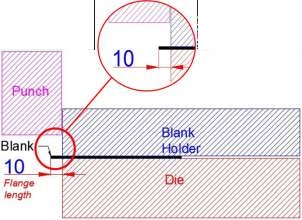 |
Figure 1. The experimental setup for stretch flanging and the flange length measurement.
Figure 2 show the stretch flanging operation. The corner edge will have a large tensile stress during the stretch flanging process.
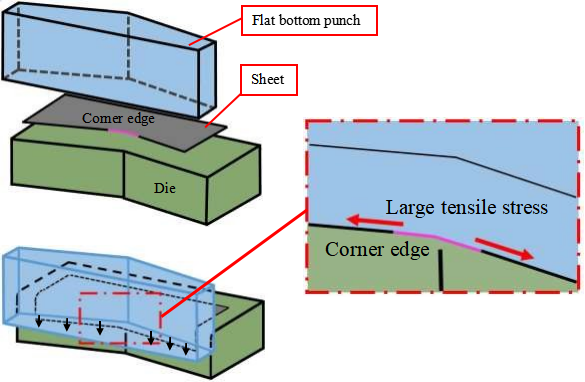 |
Figure 2. Stretch flanging process with flat bottoming punch.
Specimens are produced from the process of EDM wire cutting. The wire speed is set at 50 mm/min and the spindle feed at 5 rev/min. The finished product is shown in figure 3(a) with the dimension 100 x 10 x 2 mm. The cutting direction with consider the orientation is shown in figure 3(b). Tensile test is conducted for a specimen under a room temperature, heated at 700°C, 800°C and 900°C. Figure 3(c) shows the physical changes after the specimen is extended. The result from the tensile test are shown in Figure 4.
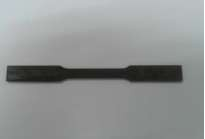
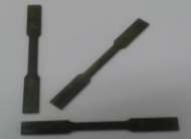
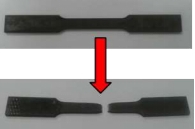
Figure 3(a). The finished specimen after wire cutting process.
Figure 3(b). The cutting direction with considering different orientation.
Figure 3(c). The specimen before and after tensile test
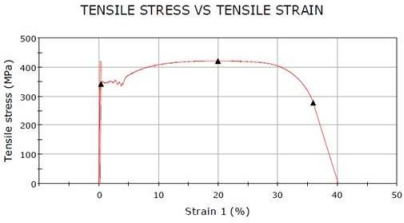 |
Figure 4. Stress strain graph for 0° orientation. The specimen is heated at 700°C.
From this test, the results show the mechanical properties obtained from the test for a different orientation heated under different temperature. Stress strain graph acquired shows the pattern of the graph before and after the materials undergo plastic deformation. By referring to the graph, the value of tensile stress at maximum load is 420 MPa whereas yield stress is about 342 MPa. The specimen starts to deform and fracture at 278 MPa.
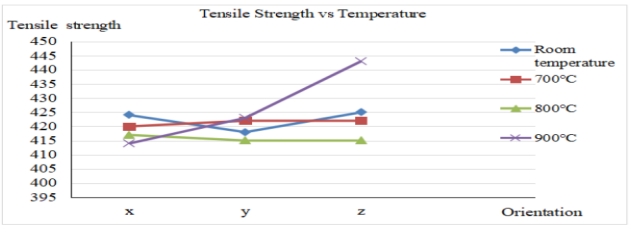
Figure 5. Graph of tensile strength against temperature.
For the x-orientation, tensile strength decreases the temperature increases. Differ from y and z- orientation; they achieved a maximum tensile strength at 900°C. For z-orientation, it gives the highest value of tensile stress compare to the others (refer Figure 5). However, the higher the strength of the material, manufacturing will be more challenging and difficult. Based on this results, the process proceeds with x-orientation, the commonly used direction when perform a stamping with high temperature ranging 700°C to 800°C when heated. This is because the material was at the best condition so that the stamping process can easily conducted and fracture may be prevented.
Generally, good hardness means that the material is high resistant to scratching and wear. It is commonly used because they are quick and convenient for assessing material properties. Hardness Vickers test is applied during this research. The surface of the material was grind and polished to have flat and smooth surface. The mould is prepared for the specimen as shown in Figure 6. Then, diamond is indented along the surface. The hardness values appear on the PC screen after the indented area iscalculate. Based on the graph, the distribution of hardness values under different temperature do not shows consistency in plotted graph. The values range between 120HV to 180HV. The high strength steel sheets achieved the highest hardness when heated with 800°C.
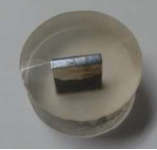 |
Figure 6. After polished and mounted. The specimens are prepared for hardness test.
 |
Figure 7. Graph of hardness versus temperature.
Result obtained from the stamping process are shown in Figure 8. For the first attempt, the sheet is tested at room temperature. As can be seen, the fracture formed at the flanged area. This is due to the unheated material has a high tensile strength compared to heated material. Therefore, the material is hard to form and crack is highly occurring in this case.
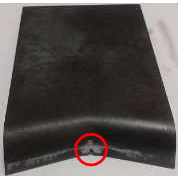 |
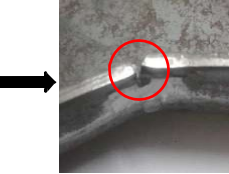 |
Figure 8. Specimen after stamping operation. At room temperature, the high strength steel sheets fractured as shown in the circle.The next test is with the same condition; the sheet does not undergo heating process but the sheet is flip to another side to identify whether there is a crack formation when stamping is performed. The result remains the same as the fracture still occurs on the material. It is due to the burr formation after cutting the material into V-shape.
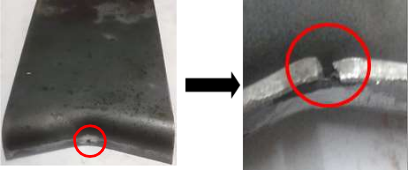 |
Figure 9. Specimen after stamping operation. In reverse position, where the high strength steel sheets are flipped to other side; fracture occurs as shown in the circle.
Another steel sheets are applied with light oil which is coolant oil around the surface cutting area. However, the problem still occurs as there is no effect although the oil is applied to the surface. Oil usually acts as the cooling reagent and heat can be reduces during stamping operation.
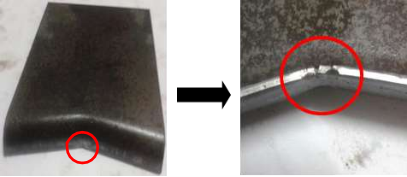 |
Figure 10. Specimen after stamping operation with applying light oil (coolant oil) to the surface.Fracture occurs as shown in the circle.
The next high strength steel sheets are applying with heavy oil which is grease. But the crack still occurs around the flange part. It shows that there is no effect although the material is applied with oil.
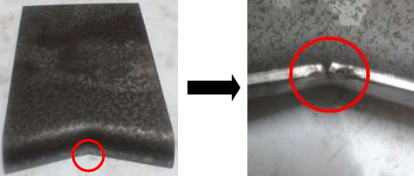 |
Figure 11. Specimen after stamping operation with applying heavy oil (grease) to the surface. Fracture occurs as shown in the circle.Another sheet is polished with sand papers to remove the burr. Burr is the main problems as more stress will be concentrated at the flange area. The effect of excessive stress to the material are the fracture may occur as shown in Figure 12.
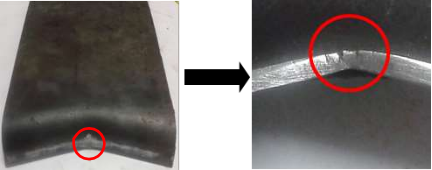 |
Figure 12. Specimen after stamping operation. The surface was polished to remove the burr. Fractures still occur as shown in the circle.
The remaining high strength steel sheets are heated under different temperature which are 700°C, 725°C, 750°C and 800°C. heating process assist the mechanical structure of the sheets so that the fracture can be prevented. As shown in Figure 13, for all temperature used; there is no fracture form but only contribute to the thickness distribution along the edge.
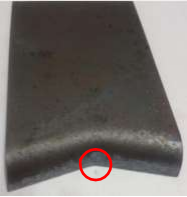 |
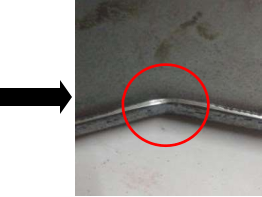 |
Figure 13. Specimen that are heated. The flange part is good (no fracture)
Thickness distribution of the flanged part shows a slightly different for the different temperature. Figure 14 shows the distribution sheets thickness that has been measured. The measured point is 2 mm from the centre line of the flanged sheets and the distances from point to point are fixed to 2 mm.
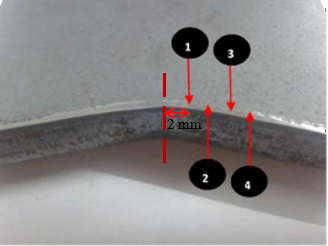 |
Figure 14. Specimen that are heated are only showing different in thickness distribution at the numbered region.
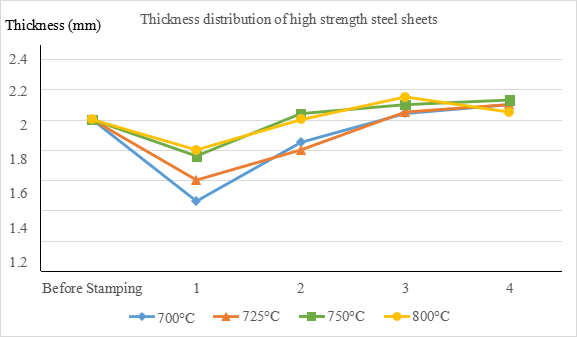 |
Figure 15. thickness distribution of high strength steel sheets.
It is found that among the factor that contributed to the fracture is the formation of burr and the crack at the edge of the sheet initiate the fracture thus polishing the sheet edge is one of the best solutions to this problem and it will be more successful if the material is polished before heated. Study also showed that applying oil does not contributed the prevention of fracture to the steel sheets. However,through heating up the sheet before flanging had increase the formability of the high strength steel. Fracture or crack are prevented by hot stamping. The length of the flange is increased by using this method. Heating process helps to reduce the strength of the materials so that the forming process will easily performed. Lastly, the result obtained will be much better when a stamping is done.
References
[1]Ingarao G, Di Lorenzo R and Micari F 2011 J. Cleaner Production 19 337-47
[2]Mori K, Maki S and Tanaka Y 2005 CIRP Annals – Manufac.Tech. 54 209-12
[3]Hasnulhadi J, Mori K and Abe Y 2014 Procedia Eng 81 843-48
[4]Hamedon Z, Abe Y and Mori K 2001 Materials. Sci. and Eng. 114 01
[5]Takahashi M, Uenishi A and Kuriyama Y 2000 Nippon Steel Technical Report 81.0
[6]Gan W and Wagoner R H 2004 Inter. J. Mech. sciences 46 1097-113
[7]Hamedon Z, Mori K and Abe Y 2014 Procedia Eng. 81 2074-79
[8]Mori K, Abe Y and Suzui Y 2010 J. Materials Processing Tech. 210 653-59
[9]Hamedon Z, Mori K and Abe Y 2014 J. Materials Processing Tech. 214 945-50
[10]Kim Y H and Park J J 2002 J. Materials Processing Tech. 130–131 42–6
[11]Kusumi K, Nomura N and Maki J 2013 Nippon Steel Technical Report no. 103
[12]Maeno T, Mori K and Hamedon Z 2012 Steel Research Inter. SPL. ISSUE 287-90
| |
|
|
上一篇文章:汽车模具设计(成型翻边整形)设计过程记录卡
|
|